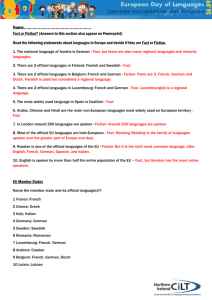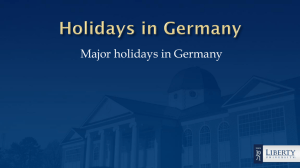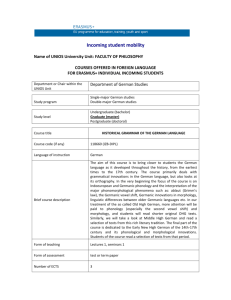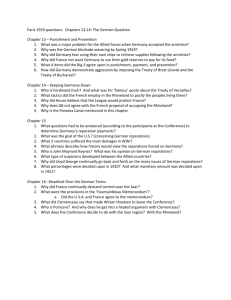The pluricentricity of German
advertisement
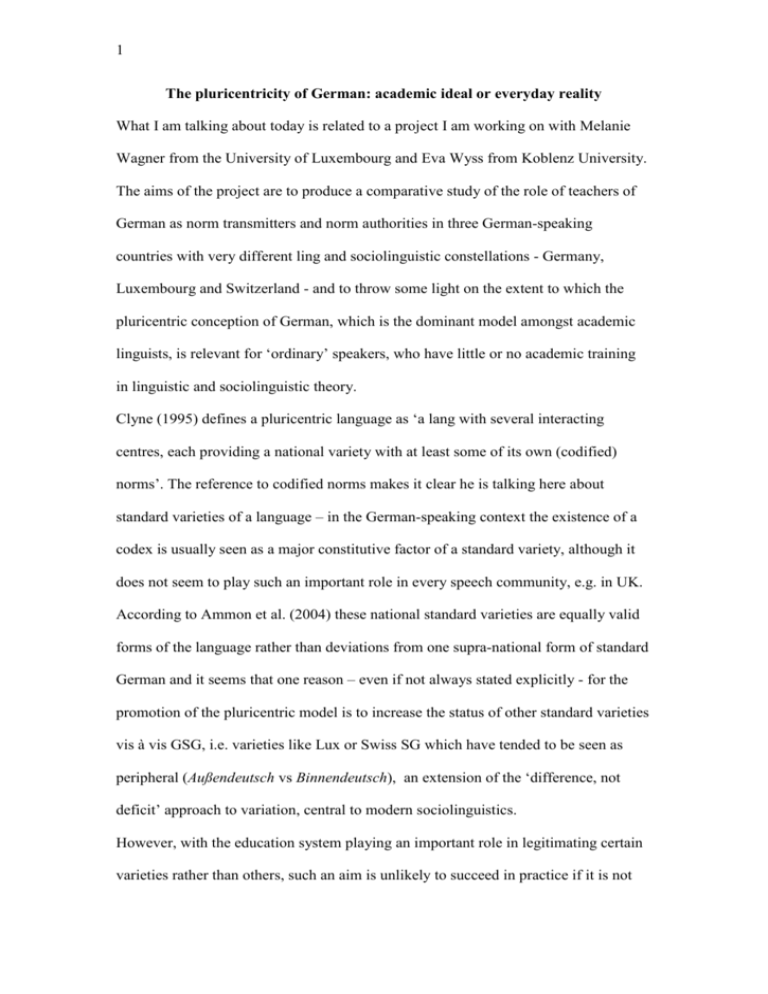
1 The pluricentricity of German: academic ideal or everyday reality What I am talking about today is related to a project I am working on with Melanie Wagner from the University of Luxembourg and Eva Wyss from Koblenz University. The aims of the project are to produce a comparative study of the role of teachers of German as norm transmitters and norm authorities in three German-speaking countries with very different ling and sociolinguistic constellations - Germany, Luxembourg and Switzerland - and to throw some light on the extent to which the pluricentric conception of German, which is the dominant model amongst academic linguists, is relevant for ‘ordinary’ speakers, who have little or no academic training in linguistic and sociolinguistic theory. Clyne (1995) defines a pluricentric language as ‘a lang with several interacting centres, each providing a national variety with at least some of its own (codified) norms’. The reference to codified norms makes it clear he is talking here about standard varieties of a language – in the German-speaking context the existence of a codex is usually seen as a major constitutive factor of a standard variety, although it does not seem to play such an important role in every speech community, e.g. in UK. According to Ammon et al. (2004) these national standard varieties are equally valid forms of the language rather than deviations from one supra-national form of standard German and it seems that one reason – even if not always stated explicitly - for the promotion of the pluricentric model is to increase the status of other standard varieties vis à vis GSG, i.e. varieties like Lux or Swiss SG which have tended to be seen as peripheral (Außendeutsch vs Binnendeutsch), an extension of the ‘difference, not deficit’ approach to variation, central to modern sociolinguistics. However, with the education system playing an important role in legitimating certain varieties rather than others, such an aim is unlikely to succeed in practice if it is not 2 shared by teachers as norm transmitters, and by policy makers and curriculum writers who tell teachers what norms to transmit. Both these groups mediate between theoretical concepts like pluricentricity and everyday practice. In our project we are particularly interested in teachers as a sub-group of what we called ‘ordinary’ speakers as opposed to professional linguists. The grammar-school teachers of German in our study are clearly not completely lacking in linguistic training since they will have studied German as a subject at university and are likely to have taken at least an introductory course in linguistics, but, despite that, I think we can safely say that they are not experts in the same way as professional linguists. The term ‘pluricentric’ need not be understood as a synonym of ‘plurinational’, but in the German context it has tended to be interpreted in that way, with centres being equated with nations, or at least states (Clyne’s definition which I’ve just cited refers to national varieties). The introduction of the pluricentric model has certainly made professional linguists and some text-book writers, mostly in the fields of German as a foreign or second language, more aware of the national dimension of variation in German, although some critics think that it over-estimates the importance of the state borders between the Gm-speaking countries. Some of the critics of the pluricentric model have suggested that the term ‘pluriareal’ is more appropriate to describe the situation in the German-speaking world, since it accepts the fact of regional variation but does not link it to national centres. Those who favour a pluriareal model argue that the pluricentric model downplays the amount of internal variation within the states where German is spoken and also implies that ‘national’ variants do not cross national borders. These are valid points but we would argue with Clyne (1995: 25) that the critics do not always respect the fact that the status of variants that exist in more than one national centre often differs, 3 i.e. they may be regarded as standard in one centre but not over the border in another. Despite the criticisms, we believe that the pluricentric (understood as plurinational) model can still help us to conceptualise and understand one dimension of variation in German. This is something we might wish to return to in the discussion. Quite a lot has been written about how best to teach German as a pluricentric language to foreigners learning German, either in a German-speaking country or abroad, but there is little on the relevance of the model for teaching German to nativespeakers, e.g. no reference to it in the curricula for German in Germany or Lux. Some of the CH curricula refer rather vaguely to ‘the characteristic features of the Swiss language situation’ and say that pupils should know about them, but there is little concrete information on what these are, and the only time we came across the term ‘Helvetismen’ (i.e. specifically Swiss features) was in the context of pupils being required to avoid them. There are a few studies which have tried to establish empirically how valid and relevant the description of German as a pluricentric language is once we move outside academia, e.g. Scharloth (2005) found that informants in Gm-speaking CH tended to downgrade SSG forms relative to GSG forms, but Pfrehm (2011: 52) found that his Austrian informants (and I quote) ‘do in fact perceive the 18 ASG lexical variants as standard when asked to rate them in the context of “when writing a school essay” ’. This could well reflect the different role played by standard German in each country, but as A is not part of the present project I can’t really say more about this now. Since the situation in the three countries represented in our project is so different I’ll give a very brief characterisation of each one and I apologise in advance that I don’t have time to do justice to the full complexity of the situations in this brief overview but will pick out a few salient points. 4 Switzerland CH is usually described as a full centre in the pluricentric model (e.g. by Ammon 1995) because Swiss Standard German has been codified and the codified norms are endonormative, i.e. produced in the national centre (this is what Ammon claims, but…) . Gm-speaking CH was one of the examples used by Ferguson when he introduced the concept ‘diglossia’ in his 1959 article (SG as the H variety and the Swiss Gm dialects as the L variety), but it is debatable whether the term still accurately describes the Swiss situation, with the Swiss German dialects (which are very different from GSG and SSG) being used frequently in domains previously reserved for SG. Berthele (2004), for example, suggests that ‘bilingualism’ would correspond better to most speakers’ perceptions of the situation and a recent call by some politicians for teachers to be brought from Gmy to teach standard German in schools in German-speaking CH, as well as the campaigns against teaching two foreign langs at primary schools (i.e. an extra one on top of st Gm) appear to back up his claim. Luxembourg Lux sets great store by its image as a trilingual country with most native Luxembourgers speaking French, German and Luxembourgish, even if not necessarily all to the same standard or with equal enthusiasm. Lux is a Gmic variety, closely related to the Moselle-Franconian varieties which are spoken in neighbouring parts of Gmy and which are there regarded as non-standard dialects. In Lux the official discourse constructs Gm and Luxembourgish as 2 autonomous langs, and the 1984 Language Law describes the latter as the ‘langue nationale’(law drawn up in French). In the pluricentric model Luxembourg is usually described as a half centre because it does not have its own endonormative codex although, acc’g to Clyne 5 (1995), there are speakers/writers who are seen as models for ‘correct’ or acceptable Luxembourg German. Despite the fact that most official and much non-official discourse (e.g. readers’ letters) stresses that Lux is separate from German, in education the close relationship with German is stressed in order to justify teaching literacy through German rather than French. Gm is the medium of teaching at primary school and children are taught to read and write in Gm not Lux. Germany It is often claimed that the link between language and national identity is particularly strong in Germany. There is however no reference to German as official or national language in the federal constitution, although there have been attempts recently to say explicitly in the federal constitution that the language of the Federal Republic of Germany is German (a prescriptive and not really accurate statement). In the pluricentric model Gmy is seen as a full centre, with a comprehensive codex of reference works containing endonormative norms. Some of these works lay claim to being reference works of German in its entirety, not just of German German, but they show their German-centricity by labelling variants that are typical of A, Lux or CH but not those that are typical of Gmy – those are apparently seen as ‘normal’, as acceptable everywhere in Gm-speaking world. This seems to reflect the old Binnendeutsch ideology of a core surrounded by a periphery, rather than equal centres. Methods We used questionnaires to collect data from 50 grammar-school teachers of German in each country about how they (claim to) evaluate certain linguistic features (27) and we also asked about the reference works they use and the context in which teaching 6 happens. Teachers had three diff categories to choose from and they had to assume they were marking written work. We also analysed a range of curricula for the subject German in each country to see what they said about pluricentricity and the status of different national varieties of standard German. Curricula Curricula are one of the most obvious channels through which explicit language policy is mediated to the teachers and, through them, to pupils, but, as mentioned above, there is no explicit mention of the concept of pluricentricity in the curricula for any of the countries. Elspaß (2005) thinks that it will be very difficult to create a pluricentric awareness amongst German speakers in Germany, since the awareness of specifically German variants is almost totally lacking, and we found that the curricula reflect (and maintain) this lack of awareness. In Switzerland most of the curricula (produced at canton level) talk only of ‘the standard language’ or ‘High German’ with no qualifying adjective, or if there is one, then it is often an evaluative adjective like ‘gepflegt’/cultivated. We found only two occurrences of the adjective ‘Schweizer’/Swiss used to qualify ‘standard German’. The curriculum for Bern is rather confusing in that it says that pupils should aim to speak ‘correct Swiss standard Gm’, but it also mentions helvetisms as something that pupils should be able to recognise and overcome (‘überwinden’). So what is correct SSG? Is it a variety with no helvetisms? If so, how is it different from any other form of st G? The curriculum of the Zentralschweiz (valid for 7 cantons) also states that ‘The Swiss st lang differs from the varieties of other regions of the Gm-lang area’ and, later on we read, ‘one occasionally finds o.s. in sits which require a cultivated st lang, without having to deny one’s Gm-Swiss origins’, but it is unclear what consequences this is meant to have for the teaching of German and how teachers are meant to put this into practice. 7 Teachers We’ve looked at level of theory (academics) and policy makers (curricula) but what do practitioners (teachers) claim to do? We’ll illustrate with two constructions from the questionnaire. Der Entscheid: The sentence ‘Der Entscheid ist mir nicht leicht gefallen’, which includes the helvetism der Entscheid (GSG die Entscheidung = decision) was corrected by 60% of the teachers in NRW and 62% in Luxembourg, but by only 18% of Swiss teachers. None of the German or Luxembourgish teachers makes a comment referring to its status as a Swiss variant, which is perhaps not surprising since it is not marked as such in either the Duden: Deutsches Universalwörterbuch (2011) or the Wahrig: Deutsches Wörterbuch (2011), two major monolingual dicitoniares. In light of the comments in Ammon et al. (2005) that it is a helvetism which is more common in Switzerland than Entscheidung, it is rather surprising that only 66% of the Swiss teachers said it was always acceptable, although a further 16% did say it would be acceptable in certain text types (diffs between D and Lux, on the one hand, and CH on the other are significant at the 0.001 level, using Fischer’s Exact Test). Das Kamin (fireplace, masc in Gmy and Lux, neut and masc codified as correct in CH): The first surprise was that 12% of the NRW teachers said ‘das Kamin’ would always be right. The next surprise was that only 24% of the Swiss teachers said this form would always be acceptable. It’s a form that is regularly cited as characteristic of SSG (e.g. Clyne 1995). Having said that, there is significantly more acceptance of the neuter form in CH (diff between CH and Gmy is significant at .05 level, and diff between CH and L is significant at 0.01 level). 8 Conclusions There is little evidence that the pluricentric model has made much of an impact outside academia. Our analysis of the curricula for grammar schools in Germany, Luxembourg and Switzerland found no explicit references to the term pluricentricity, and we found only one reference - in the Bern curriculum - to a variety of standard German that was designated as specific to one country. Such a gap is less surprising in Germany since it reflects the monocentricity that Clyne (1992) considers one of the characteristics of a dominant centre, but is less comprehensible in the other two countries, where issues to do with language, including the role of German, are rarely out of the media or everyday conversations. Educational policy seems to have a rather large blind spot when it comes to certain aspects of sociolinguistic reality. This is all the more surprising in view of the fact that most, if not all, curricula require teachers to raise awareness of the situational and regional dimensions of variation in German and to teach pupils to communicate appropriately. It appears that teachers are very much left to their own devices when it comes to national varieties of standard German and are given little concrete guidance on how to manage in what has always been a complex situation and is becoming even more so (e.g. increasingly heterogeneous and multilingual classrooms). The reactions of the teachers to the variants do not seem to reflect a particularly marked consciousness – or rather acceptance - of separate national norms and also makes one wonder how accurate some of the descriptions of SSG in our textbooks are.

